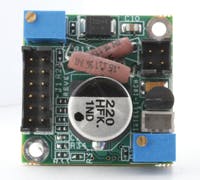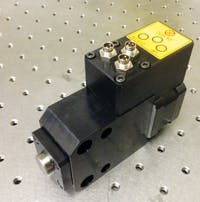Motor-powered actuator controls flow on conveyors
Engineers at Mechatronic Techniques, Plano, Tex., recently designed a motor-powered stopper to replace pneumatic and solenoid stoppers on some custom conveyors. The stoppers extend into the conveyor’s material stream to halt the flow of trays containing parts for assembly. When workstations downstream are ready, the stoppers retract and the flow of trays resumes. Previous pneumatic stoppers were inefficient and loud, and solenoid stoppers were often underpowered.
The engineering team had to get this conveyor subsystem from design to prototype in two weeks and manufacture 35 working units in one month with the help of AllMotion, Union City, Calif.
The stopper actuators consist of a custom stepper motor with a leadscrew and round-shaft bearing, plus an AllMotion Intelli-Inch stepper controller and driver. It also has a linear shaft with an antirotate feature. The controller/driver generates up to 25,000 pulses/sec and is programmed to run the motor a fixed number of steps clockwise or counterclockwise. At the end of travel, the motor simply stalls.
The actuator extends (and retracts) 11 mm in 0.5 sec to stop and release 10-tray pileups that push on the cantilevered actuator arm with about 15 lb of sideload. Besides its use in new conveyor machinery, the actuator is a drop-in replacement for pneumatic and solenoid stoppers on older machines.
Its electrical interface is similar to that for a solenoid: Wire inputs include Step, Direction, Ground, and Power, and two onboard potentiometers set Move and Hold currents.
About the Author
Elisabeth Eitel
Elisabeth Eitel was a Senior Editor at Machine Design magazine until 2014. She has a B.S. in Mechanical Engineering from Fenn College at Cleveland State University.


